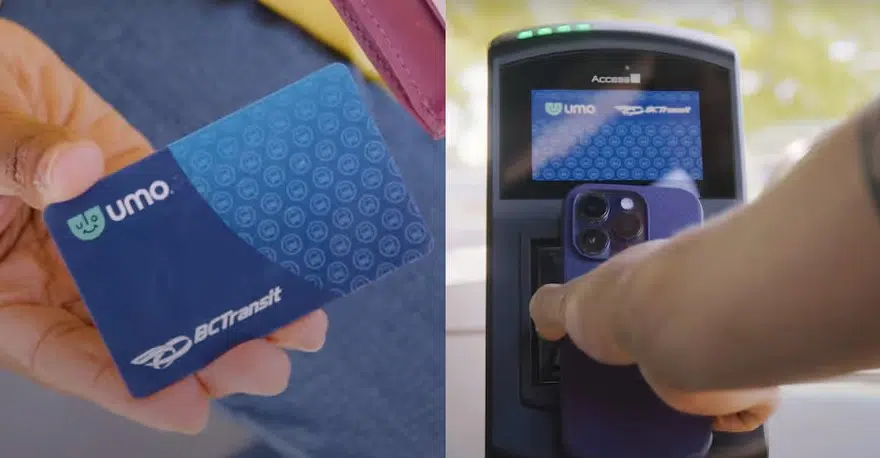
The Umo card (left) and paying a bus fare by scanning a smartphone app. (Photo via BC Transit)
The way Kamloops residents pay their bus fares will be changing as BC Transit prepares to roll out Umo in the new year.
Umo (pronounced “you-mo”) is the new contactless fare payment system similar to Compass Cards used by Translink in the Lower Mainland.
Kamloops Transportation Planner Jacob Burnley says new fare validators will be installed in each bus, with passengers able to pay fares by either tapping their Umo cards or scanning the app on their smartphones.
“We won’t be having like fare vending machines but we do have a number of existing vendors that have shown interest in supporting the Umo program,” Burnley said on the NL Noon Report.
“Essentially what that means is people will be able to go into a local business and reload their card there or they can also reload it only via the app or from home as well.”
Burnley says while there won’t be any changes to bus fares – which remain at $2 for a single ride or $4 for a day pass – the regular monthly passes that cost $50 will be moving to more flexible 30-day passes.
“If you buy a pass on the 17th, its valid till the 17th of the next month,” Burnley said, noting as things stand, people need to wait for the start of a month before they can use those passes. “That is the main fare policy change [going before council this week] and then the other one would be that we’ll still be accepting tickets but they are not going to be selling the paper sheet tickets post roll out of Umo.”
“There will be a transition period but we’re moving away from that so that we can do the fare capping. Once you pay with your card and you reach the $4 for the day, it won’t charge you for the rest of the day.”
Other specialty passes in Kamloops like U-PASS, KamPASS, and ProPASS will still be offered to people in Kamloops.
“Coordinators from organizations that issue specialty passes will be provided with benefit codes from BC Transit to assign to users to allow for discounted pass purchases,” Burnley said, in a report to City Council. “This benefit code approach could also allow other specialty passes to be developed for special one-off cases, such as conferences, sporting events, and community events.”
“Partnerships involving transit ticket distribution to local supportive agencies (e.g. United Way) may continue using Umo. Paper QR code tickets will be available to support organizations where contactless tap card distribution (and the reloading of fares) may not be practical or feasible.”

Proposed Updated BC Transit Fare Structure in Kamloops. (Photo via City of Kamloops)
Burnley also says Kamloopsians will still be able to pay their fares using cash, though as has been the case drivers will not be carrying change. The use of credit and debit cards as on-board payment options are expected to be rolled out about one year after Umo launches.
Those with Umo though will be able to use their accounts on other BC Transit systems including in Kelowna or Victoria for example.
“If you purchase a monthly pass or a specific pass for a semester those won’t be transferable, those will be specific to Kamloops or to Kelowna, but if you load just cash on your card, you’ll be able to use that stored value, that cash, in those systems,” Burnley said.
“Those accounts will be charged and adjusted based on what the fare is in that particular system.”
Umo is currently live in the Victoria Regional Transit System and its scheduled to be implemented in 29 other transit systems across the province beginning on Vancouver Island before making its way through the Fraser Valley, and finally the Interior.
Kamloops is set to become the first Interior community to get Umo, with Burnley telling Radio NL the roll out is expected to be completed in February.
You can find out more about Umo here.













